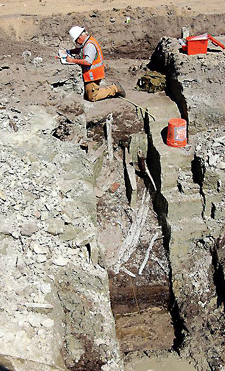
|
CONNECTIONS
|
IDAHO
ITD
HOME
IDAHO DMV
ITD
NEWS
HIGHWAY
SAFETY
IDAHO STATE
POLICE
TRAVEL SERVICES
STATE OF IDAHO
NATIONAL
AASHTO
AAMVA
AAA of IDAHO
FEDERAL HIGHWAYS
FEDERAL AVIATION
IDAHO STATE POLICE
NHTSA
NTSB
TRB
U.S. DOT
Idaho
Transportation
Department
Public Affairs Office
P.O. Box 7129
Boise, ID 83707
208.334.8005
Fax: 208.334.8563
Email

Sandpoint
Byway dig uncovers city's history
Keith Kinnaird
The Bonner County Daily Bee
SANDPOINT - Archaeologists are uncovering Sandpoint's seedy underbelly,
its working class roots and even some of its prehistory on the Sand
Creek Peninsula.
The work is being done to prepare for construction of the U.S. Highway 95 bypass, which will bisect the Sandpoint's original town site. The cultural resources evaluation is still in the testing phase, where archaeologists probe for artifacts in hand-dug holes and use heavy equipment to dig narrow trenches.
For the time being, chief archaeologist Bob Weaver is
purposefully vague about what items are being found where to discourage
people from looting sites before they can be probed.
Officers will also be patrolling the various excavation sites for suspicious
activity and persons, according to Sandpoint Police Chief Mark Lockwood.
 The
dig has yielded a mail order catalog's range of items -- everything
from liquor bottles to broken dinnerware with makers' marks and clay
pipes.
The
dig has yielded a mail order catalog's range of items -- everything
from liquor bottles to broken dinnerware with makers' marks and clay
pipes.
"A lot of it is turning up right where we thought it would," Weaver said.
A "Double Happiness" rice bowl was discovered in what was effectively Sandpoint's Chinatown. Chinese labor made major contributions to the development of railroad transportation and one contemporary observer suggested that aside from workers wearing American boots, the Chinese encampment could have passed for Canton because nearly every accouterment and custom from their homeland came here, too.
The railroad was a major factor in the settlement of
Sandpoint in the latter 1800s, although the town was initially more
of a stopping point on the way to more premier locations such as Hope
and Kootenai. Sandpoint became an area known for its "entertainments"
and somewhat wild character, according to a historical background Weaver
compiled.
"Early Sandpoint appears to have been a fairly wild town,"
Weaver wrote
"Records mention hanging and shootings; and the saloons advertised that they were open all night."
When Ella Farmin arrived in 1892, she noted that bars and brothels outnumbered stores, hotels and restaurants.
Sandpoint's bawdy past is well documented, right down a 1910 census which lists the names, ages and hometowns of bordello workers. Marie Henderson's brothel on Railroad Avenue, for instance, had a 25-year-old named Trixie Edwards, who was supposedly from France.
The concentration of dance halls, saloons and houses of ill fame became known as the "Restricted District."
Weaver and his colleagues have discovered in the district numerous glass vials which look like test tubes with squared-off bottoms. Weaver suspects these containers might have held medicines used to treat ailments associated with bordello frequenting. A bottle identifying its contents as poison was also found.
The Pend Oreille River valley was originally home to people of the Kalispel tribes and there is strong evidence that Sandpoint was a semi-permanent site in prehistory partly because of its proximity to a transcontinental trail used by many native peoples.
Prehistoric artifacts have been found during the dig. Weaver showed what appears to be the makings of a projectile point and even a "pressure flake," which is a byproduct of the stone tool-making process. The flake is about the size of a the collar flap button on an Oxford shirt -- so remarkably small and inconsequential looking that it's a wonder it was discovered at all.
Although crews have not yet turned up any items which on their own radically enhance or rewrite the historic record, Weaver said an evaluation of all the evidence together has the potential to do just that.
ITD expects to release the results of the Sand Creek Byway's cultural resources project either later this year or early next year.
Photo: Sandpoint archaeologist Bob Betts kneels while
taking notes in one of the test sites. (photo by Keith Kinnaird.)
Published 6-2-06